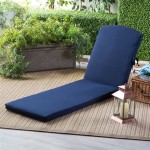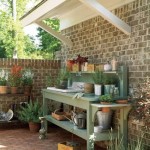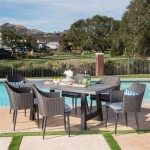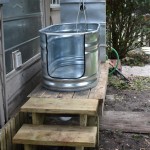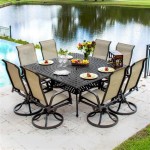Outdoor Serving Cart with Wheels: Enhanced Outdoor Entertainment
Outdoor serving carts with wheels are increasingly becoming a staple in residential and commercial outdoor spaces. These versatile pieces of furniture provide a mobile platform for transporting food, beverages, and other essential items, enhancing the functionality and enjoyment of patios, decks, and gardens. The integration of wheels introduces a degree of flexibility that stationary outdoor furniture simply cannot match, allowing for seamless transitions between the kitchen, dining area, and seating arrangements.
The primary function of an outdoor serving cart with wheels is to facilitate outdoor entertaining. Rather than requiring multiple trips back and forth from the kitchen to the outdoor area, these carts consolidate the necessary items in one convenient location. This centralization streamlines the serving process, freeing up the host to interact with guests and enjoy the event. The presence of a dedicated serving area outdoors encourages socialization and creates a more relaxed and engaging atmosphere.
Beyond mere convenience, an outdoor serving cart with wheels also contributes to the aesthetic appeal of the outdoor space. Available in a wide range of materials, styles, and finishes, these carts can complement existing patio furniture and enhance the overall design. Whether a homeowner prefers a rustic wooden cart, a sleek stainless-steel model, or a colorful resin option, there is a serving cart to suit nearly any taste and décor.
Key Considerations when Choosing an Outdoor Serving Cart with Wheels
The selection of an outdoor serving cart with wheels requires careful consideration of several factors to ensure optimal performance and longevity. These factors include material durability, size and capacity, wheel type, and additional features.
Material Durability: The material from which the cart is constructed is arguably the most important factor influencing its durability and resistance to the elements. Outdoor serving carts are typically made from wood, metal, or synthetic materials, each with its own set of advantages and disadvantages.
Wood carts offer a natural aesthetic and can blend seamlessly into traditional outdoor settings. However, wood is susceptible to moisture damage, warping, and insect infestation. Therefore, wooden carts must be constructed from weather-resistant woods such as teak, cedar, or redwood, and they require regular maintenance, including sealing and staining, to prolong their lifespan. Pressure-treated wood is also a viable option, though it can sometimes lack the aesthetic appeal of naturally durable hardwoods.
Metal carts, particularly those made from stainless steel or powder-coated aluminum, offer excellent weather resistance and are less prone to rot or insect damage. Stainless steel is highly resistant to rust and corrosion, making it an ideal choice for coastal environments. Powder-coated aluminum is lightweight and durable, offering a good compromise between strength and portability. Wrought iron is another metal option, though it requires regular painting or sealing to prevent rust.
Synthetic materials, such as resin or plastic, are highly resistant to weather damage and require minimal maintenance. These materials are often molded to mimic the look of wood or metal, offering the aesthetic appeal of natural materials without the associated upkeep. However, synthetic materials may not be as visually appealing as natural materials to some consumers. Furthermore, lower-quality plastic carts can be prone to cracking or fading over time.
Size and Capacity: The size and capacity of the serving cart should be appropriate for the intended use. Consider the number of guests typically entertained and the types of items that will be stored or transported on the cart. A small cart may suffice for intimate gatherings, while a larger cart with multiple shelves or drawers may be necessary for larger parties.
The height of the cart is also an important consideration. A cart that is too low may require excessive bending, while a cart that is too high may be difficult to maneuver. The ideal height will depend on the user's height and the intended use of the cart. Additionally, consider the weight capacity of the cart to ensure it can safely support the intended load. Overloading the cart can damage the wheels or frame, reducing its lifespan.
Specific features that increase storage capacity include multiple shelves, drawers, bottle racks, and utensil holders. Carts with drop-leaf extensions offer additional surface area when needed, while carts with built-in ice buckets or coolers provide convenient storage for beverages. Consider the specific needs and preferences when selecting a cart with the appropriate storage capacity.
Wheel Type: The type of wheels on the serving cart significantly impacts its maneuverability and stability. Common wheel types include fixed wheels, swivel wheels, and locking casters.
Fixed wheels provide stability and are suitable for moving the cart in a straight line. However, they are less maneuverable than swivel wheels, making it difficult to navigate tight spaces. Swivel wheels offer greater maneuverability, allowing the cart to be easily turned and directed. However, they can be less stable than fixed wheels, particularly on uneven surfaces.
Locking casters combine the advantages of both fixed and swivel wheels. They can be locked in place to provide stability or unlocked to allow for easy maneuvering. This feature is particularly useful for preventing the cart from rolling away on sloped surfaces. The size of the wheels also affects maneuverability. Larger wheels generally roll more easily over uneven surfaces, while smaller wheels may be more suitable for smooth surfaces.
The material of the wheels is also an important consideration. Rubber wheels provide good traction and cushioning, while plastic wheels may be more durable and easier to clean. Consider the type of surface on which the cart will be used when selecting the appropriate wheel material.
Additional Features to Enhance Functionality
Beyond the fundamental components of material, size, and wheels, several additional features can enhance the functionality and convenience of an outdoor serving cart. These features include built-in coolers, side handles, and covers.
Built-in Coolers: Carts with built-in coolers provide a convenient way to keep beverages and food cold without the need for separate ice chests. These coolers are typically insulated to maintain a consistent temperature and often include drainage plugs for easy cleaning. Some carts feature removable coolers that can be easily transported or replaced.
The size of the cooler should be appropriate for the number of beverages or food items to be stored. Consider the type of insulation used in the cooler to ensure it can maintain a cold temperature for an extended period. Features such as bottle openers and ice scoops can further enhance the convenience of a built-in cooler.
Side Handles: Side handles provide a comfortable and secure grip for maneuvering the cart. They are particularly useful when moving the cart over uneven terrain or up and down stairs. Handles are typically made from wood, metal, or plastic and should be ergonomically designed for comfortable use. The placement of the handles should also be considered. Handles that are too low or too high may be uncomfortable to use. Some carts feature adjustable handles that can be customized to the user's height.
Covers: Covers protect the serving cart from the elements when not in use. They can prevent the cart from becoming soiled by dirt, dust, or rain, extending its lifespan and reducing the need for frequent cleaning. Covers are typically made from water-resistant or waterproof materials and should be securely fastened to the cart to prevent them from being blown away by the wind. Some covers also feature UV protection to prevent the cart from fading in direct sunlight.
In addition to these key features, many outdoor serving carts offer other conveniences, such as adjustable shelves, removable trays, and foldable designs for easy storage. Carefully consider these additional features when selecting a cart to ensure it meets specific needs and preferences.
Maintenance and Care for Longevity
Proper maintenance and care are essential for prolonging the lifespan of an outdoor serving cart with wheels. The specific maintenance requirements will vary depending on the materials from which the cart is constructed, but some general guidelines apply to all types of carts.
Regular cleaning is crucial for preventing the accumulation of dirt, dust, and grime. Use a mild soap and water solution to clean the cart's surfaces, and rinse thoroughly with clean water. Avoid using harsh chemicals or abrasive cleaners, as these can damage the finish. Pay particular attention to cleaning the wheels and casters, as these can become clogged with debris. Lubricate the wheels periodically to ensure smooth operation.
For wooden carts, regular sealing or staining is necessary to protect the wood from moisture damage and insect infestation. Apply a sealant or stain appropriate for outdoor use and follow the manufacturer's instructions carefully. Inspect the wood regularly for signs of rot or decay, and repair any damage promptly. If the cart is stored outdoors during the winter months, consider covering it with a waterproof tarp to protect it from snow and ice.
For metal carts, check for signs of rust or corrosion and treat any affected areas promptly. Use a wire brush to remove rust, and then apply a rust-inhibiting primer and paint. For carts with powder-coated finishes, avoid using abrasive cleaners, as these can scratch the coating. When storing the cart outdoors, consider covering it with a waterproof cover to protect it from the elements.
For synthetic carts, cleaning is typically easier than with wood or metal carts. Simply wipe the cart down with a damp cloth and mild soap as needed. Avoid using harsh chemicals or abrasive cleaners, as these can damage the surface. Check the cart regularly for cracks or damage, and repair any issues promptly.
By following these maintenance and care guidelines, homeowners can ensure that their outdoor serving cart with wheels remains in good condition for years to come, providing a convenient and stylish addition to their outdoor entertaining space.

Maypex Brown Steel Frame 2 Tier Wicker Outdoor Bar Cart With Wheels And Bottle Holder 300595 The Home

Serving Cart

Indoor Outdoor Folding Serving Cart With Wheels Shelves Black Room Joy

Alfresco Ii Grey Outdoor Bar Cart With Casters Reviews Crate Barrel

Salonmore Outdoor Wicker Bar Cart On Wheels Walmart Com

Sei Murcott Outdoor Bar Cart 33 12 H X 43 34 W 22 D Naturalblack Office

Pamapic Wicker Outdoor Bar Serving Cart With Wheels Tb Tc Z Mh3 The Home

Buy Teak Serving Cart Online Teaklab

Style Selections Pelham Bay 33 In X 19 Black Steel Foldable Patio Serving Cart Lg 20246 Fbc Rona

25 Best Outdoor Bar Carts And Grill Stations In 2024 Hgtv
See Also


